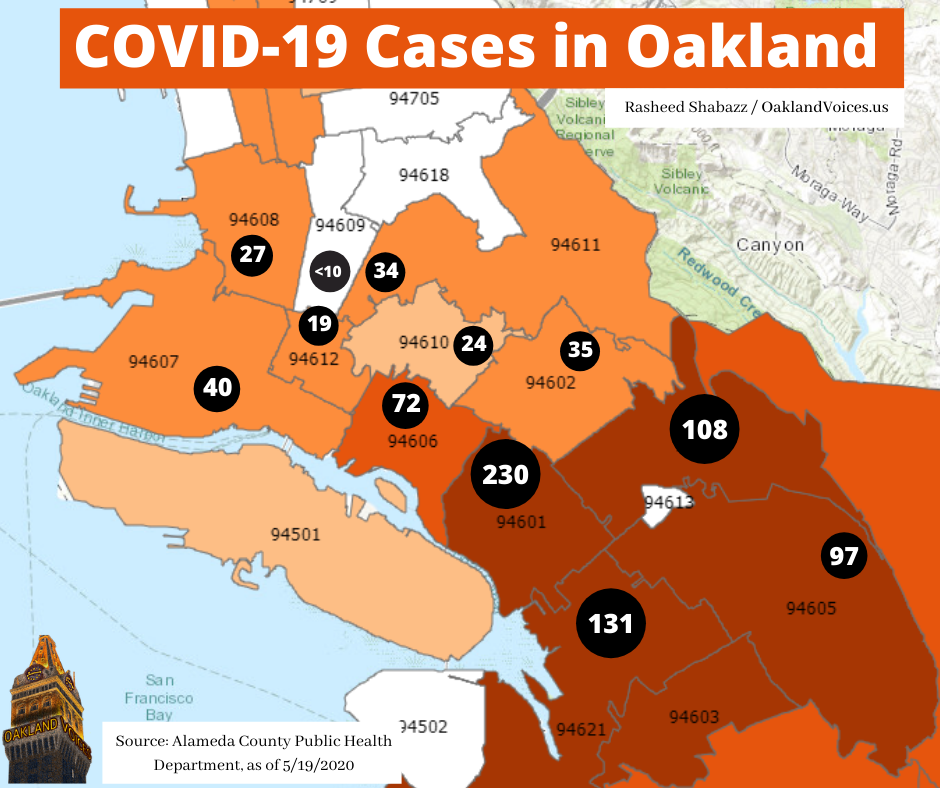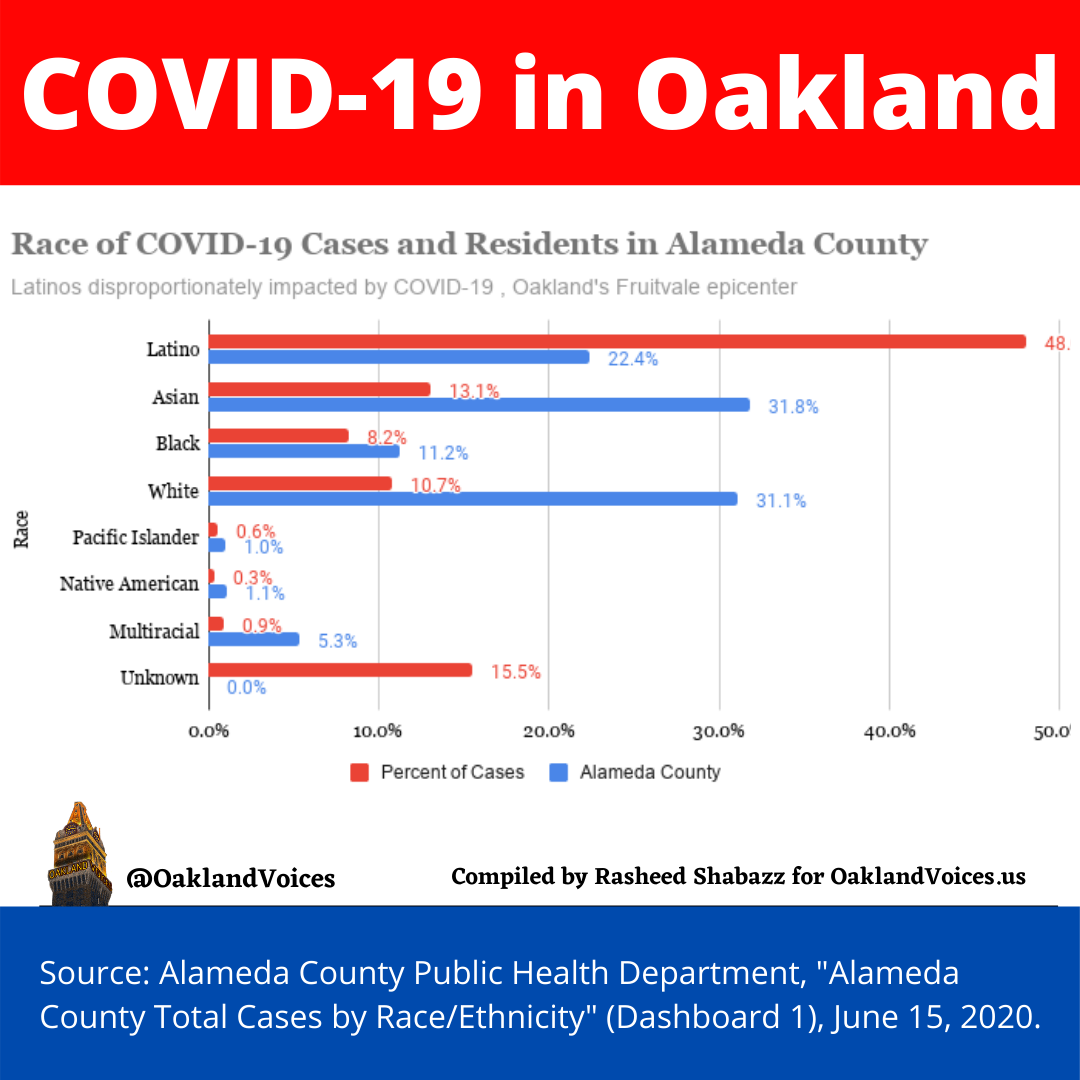
Alameda County reentered the “Red Tier” nearly two weeks ago, as Oakland Voices reported, allowing indoor businesses and activities to resume. Restaurants, grocery stores, movie theaters, and gyms can reopen with capacity restrictions and modifications. Groups of up to three households can gather indoors, although outdoors is still encouraged. Masks and physical distancing is still required.
Beginning April 1, outdoor sports and live performances with fans will be allowed at up to 20 percent capacity.
The statewide Blueprint for a Safer Economy includes four key indicators, including the seven-day averages of the number of COVID-19 cases per 100,000 people, average of all COVID-19 cases that are positive (positivity rate), and number of vaccine doses administered.
Vaccine inequality in Oakland
Equity is also a key indicator for reopening. According to the state, 40 percent of all COVID-19 cases and deaths occur in California’s lowest Healthy Places Index (HPI) quartile. The HPI visualizes social determinants of health like low income, education levels, and access to health care. To end the pandemic, the state has set aside 40 percent of vaccine doses for communities hit hard by the pandemic. In Oakland, this includes zip codes: 94601, 94603, and 94621. According to Alameda County, despite just three priority zip codes falling in the state’s Vaccine Equity Quartile, local efforts also include parts of West and East Oakland, as well as Ashland/Cherryland and South Hayward.”
Social media observations of recent vaccination pop ups in East and West Oakland targeting Black and Brown communities are being utilized by white residents. It is unclear of they are neighborhood residents. KGO reported on the lack of vaccine equity statewide.
According to Alameda County’s COVID-19 Vaccination dashboard, to date: 34 percent of Oakland residents have received a first dose and 18 percent are fully vaccinated. By race and ethnicity, the percentage of groups that have received a first dose breaks down as follows:
Native American, 38.9%, White, 33%; Asian 29.8%, Black, 24%, Latino, 19%. A large number of doses are categorized as “unknown.” Overall, 682,919 vaccine doses have been administered, including 444,763 first doses and 234,566 second doses. (As an educator, I have received the first dose.)
Oakland schools start reopening next week
Last week, OUSD and the Oakland Education Association, the teacher’s union, announced a tentative agreement to return all members back to campus in two phases this month.
The agreement allows students to continue distance learning, if they choose.step forward for our students, families and staff, as we all can now see the light at the end of the tunnel of this year-long ordeal,” Superintendent Kyla Johnson-Trammell said. “I look forward to March 30 with great excitement for students and staff who are eager to be together again.”
Phase 1 would begin next week with in-person instruction for pre-K to 2nd grade and priority students. The opt-in phase would begin with preparations this week. Phase 2 would begin April 19 and expand in-person instruction through fifth grade and include at least one secondary grade, according to the announcement. Campuses will operate at a “limited capacity” based on local public health guidelines. Families may choose to continue distance learning.
“We reached a tentative agreement that is just, equitable, and most importantly, safe. We believe that phasing in student return on April 19 allows all educators to complete their vaccinations, if they so choose, and for California’s targeted vaccination program to reach our most vulnerable communities,” said Oakland Education Association President, Keith Brown. “This agreement also provides time to engage in the work of setting up the next agreement for a comprehensive hybrid model, which would meet the unique needs of our students, families, and members.”
Oakland’s communities of color in the flatlands have been hit hardest by the pandemic. Tensions over reopening have also raised issues of racial equity. A group of protesters calling for reopening were criticized for its lack of racial diversity, despite Oakland students being majority Black, Latino, and Asian. Equity
“Recognizing that communities of color have been disproportionately impacted by the pandemic, we agreed on an equity-based model that prioritizes the distribution of resources to those communities,” said Oakland Education Association Second Vice President and Bargaining Chair, Chaz Garcia. “The pandemic has exacerbated a lot of the issues (funding, classroom sizes, ventilation, conditions of schools, etc.) we have been battling with for decades.”
The pandemic has highlighted the critical role of schools, teachers and other school workers. Since the pandemic, Oakland schools have distributed over 10 million student meals-and almost 3 million pounds of food from the Alameda County Community Food Bank, according to OUSD.
This is also the last week for students to accept enrollment offers for the 2021-2022 school year.
COVID-19 cases in Oakland
Daily cases have fallen significantly since this past winter. Alameda County has 82,593 COVID-19 cases and 1,369 deaths. Oakland has 25,662 cases. Of cases, 33,121 have been Latino, 11,000 white, 10,280 Asian, and 6,403 African American. East Oakland, below Bancroft Ave, from 23rd Ave to San Leandro has been hardest hit by the pandemic, in terms of cases.
Rasheed Shabazz is a multimedia storyteller, urban planning historian, and youth development professional based in the Bay Area. He is co-director of Oakland Voices. He recently completed his Masters of City and Regional Planning at UC Berkeley.





Be the first to comment